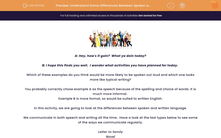
A: Hey, how's it goin? What ya doin today?
B: I hope this finds you well. I wonder what activities you have planned for today.
Which of these examples do you think would be more likely to be spoken out loud and which one looks more like typical writing?
You probably correctly chose example A as the speech because of the spelling and choice of words. It is much more informal.
Example B is more formal, so would be suited to written English.
In this activity, we are going to look at the differences between spoken and written language.
We communicate in both speech and writing all the time. Have a look at the text types below to see some of the ways we communicate regularly.
Letter to family
Novel
Newspaper
Texts
Emails
Chat with friends
Assembly
Interview
Meeting new people

You will change the way you speak or write depending on who you are speaking or writing to and what your intention is.
We call this the audience and the purpose.
It wouldn't be a good idea to speak to your headteacher in the same way that you would to your best friend, and you wouldn't write the same text message to your parents as you would to a friend. We call this formality.
Formal communication means using standard English and usually some level or respect and politeness. It is used in situations such as an interview or a letter to a professional. When speaking, you would try to be clear and fluent. In writing, you would use accurate punctuation and paragraphs.
Informal communication means that you might include colloquialisms, slang or miss out punctuation. It is used when you know the audience well and you don't need to impress or show respect.

If you are ready, let's try out some questions.








